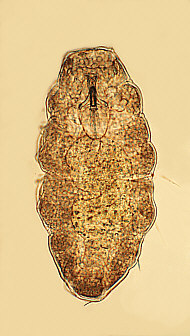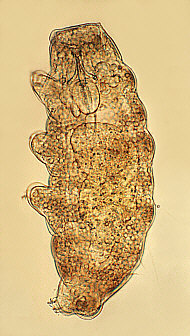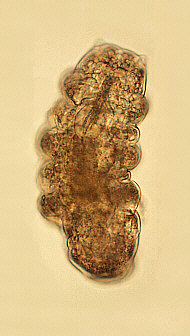![[Title fragment 1.1]](t1_1.gif)
![[Title fragment 1.2]](t1_2e.gif)
![[Title fragment 1.3]](t1_3e.gif)
![[Title fragment 3.1]](t3_1.gif)
![[Title fragment 3.2]](t3_2.gif)
![[Title fragment 3.3]](t3_3e.gif)
![[Title fragment 1.1]](t1_1.gif)
|
![[Title fragment 1.2]](t1_2e.gif)
|
![[Title fragment 1.3]](t1_3e.gif)
|
|
|
|
|
![[Title fragment 3.1]](t3_1.gif)
|
![[Title fragment 3.2]](t3_2.gif)
|
![[Title fragment 3.3]](t3_3e.gif)
|
In this issue we will have a look at the fascinating ability of the
tardigrades to survive in a completely dry state (so-called anhydrobiosis).
We will above all concentrate on the visual side of this process, whereas
the next issue will discuss the chemistry behind. |
![[Echiniscus tardigrades on moss glass hair]](j_pic5rkl.jpg) |
Echiniscus tardigrades
in dry state on a moss glass hair. |
When the process of desiccation begins tardigrades tend to cling
to protecting plant shelters. This has several advantages, e.g. it reduces
the danger of being flooded away by water but above all the process of
desiccation has enough time to proceed in an optimum manner. Furthermore
the less protected ventral side of the tardigrade body is covered by the plant.
|
![[ tardigrades ; dry form of an eutardigrade water bear]](j_ton7.jpg) |
Very regular, symmetric tun of an eutardigrade water bear formed after slow desiccation. Length ca. 0.2 mm. |
Although the visual appeal during dry state appears to be harmonic and peaceful it should be kept in mind that the animals are in fact close to death and have to trust blindly on the development of a better future. It happens from time to time that in particular senile water bears do not find back to active live after rehydration. |
![[dry state short after addition of water droplet]](j_00.jpg) |
Eutardigrade in the phase of stretching short after the beginning of rehydration. |
It is possible to trace different phases of rehydration, all of which are finished after about 10 to 15 minutes. The series of fotos below shows the revival of a tardigrade of the Macrobiotus hufelandi group. The initial size of tun is 0.3 mm. |
 |
 |
 |
|
|
|
 |
 |
 |
|
|
|
|
A critical observer might have noticed a logical gap between photomicrograph 4
and photomicrograph 5. The reason for this is that at this moment the cover glass
had to be lifted carefully and removed at this moment in order to provide the
tardigrade with sufficient space and oxygen.
LiteratureHartmut Greven: Die Kryptobiose der Bärtierchen. Mikrokosmos 62 (1973) S. 65-69. |
© Text, images, and video clips by
Martin Mach (webmaster@baertierchen.de).
|